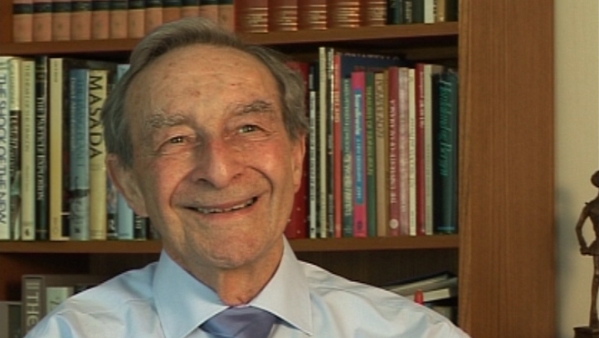NEXT STORY

My role in IUPAC
RELATED STORIES

NEXT STORY

My role in IUPAC
RELATED STORIES


|
Views | Duration | |
|---|---|---|---|
| 101. My graduate students: Peter Perkins and Ian Worrell | 87 | 02:18 | |
| 102. Expansion of the Department of Chemistry at Nottingham University | 73 | 03:44 | |
| 103. My role in IUPAC | 46 | 02:22 | |
| 104. Establishing atomic weights | 50 | 03:35 | |
| 105. Forming a team at IUPAC | 39 | 01:22 | |
| 106. How isotopes affect atomic weight | 51 | 01:27 | |
| 107. Geochemistry determining atomic weight | 45 | 02:14 | |
| 108. How radioactivity affects atomic weight | 46 | 04:36 | |
| 109. The Oklo Phenomenon | 96 | 05:28 | |
| 110. The Oklo sake vase made for me | 54 | 01:10 |


So by this stage I had a nucleus of research workers, they were very productive, highly motivated, we had a great time together at a very useful lab. But then a new event occurred and that was, because of the growth of Nottingham University, after its foundation as an independent university in 1948, it, of course, expanded. And with the expansion came lack of space. Fortunately Sir Jesse Boot, who was the principal of Boots, the chemist, had his factory for making pharmaceuticals just down by the Trent, and he gave a huge tract of land at Highfields – you will remember University Park, and the university could expand there from the original buildings into more salubrious accommodation. In fact, I was doing work in temporary huts. The temporary huts were only finally removed a few years ago, in fact, but they served a valuable purpose. But in amongst building up a graduate school and designing lecture courses with Cliff Addison – and Eric Addison then joined us as well – there was a new project and that was the new chemistry building.
That was built under the architect, Sir Basil Spence, who had some interesting design concepts which were incorporated into the building. And that building, I think, came on stream in 1960.
[Q] 1960, Norman.
1960, yes, that's true. So, for 1957, 1958, 1959 there was building and designing and so forth, and Cliff and I had a good time working out laboratory designs, practical work designs, where the research workers went and so forth. And that building, as far as the inorganic is concerned, followed closely on the designs that we had. On the physical chemistry side, Dan Eley was developing his group there, he'd come from Bristol and he was the professor of physical chemistry, and Freddie King who's a distinguished organic chemist left to go into industry and his place was taken by Alan Johnson as the professor of organic chemistry.
But one interesting feature of the chemistry department was that all branches of chemistry were taught equally – inorganic, organic and physical. A third, a third, a third, which was quite unusual in those days. Each had a professor in the end as head because Cliff Addison was promoted to... from reader to a professor, and so there were three independent research groups, but the undergraduate programme was developed in a coordinated way and each part of chemistry had a fair swipe at the course work.
Norman Greenwood (1925-2012) was born in Australia and graduated from Melbourne University before going to Cambridge. His wide-ranging research in inorganic and structural chemistry made major advances in the chemistry of boron hydrides and other main-group element compounds. He also pioneered the application of Mössbauer spectroscopy to problems in chemistry. He was a prolific writer and inspirational lecturer on chemical and educational themes, and held numerous visiting professorships throughout the world.
Title: Expansion of the Department of Chemistry at Nottingham University
Listeners: Brian Johnson
Professor Brian FG Johnson FRS, FRSE, FRS Chem, FAcad Eu, FAS. Professor of Inorganic Chemistry University of Edinburgh 1991-1995, Professor of Inorganic Chemistry University of Cambridge 1995-2005, Master Fitzwilliam College Cambridge 1999-2005. Research interests include studies of transition metal carbonyls, organometallic chemistry, nano- particles and homogeneous catalysis. Professor Johnson is the author of over 1000 research articles and papers.
Tags: Nottingham University, 1948, Boots, Trent, Highfields, University Park, 1960, 1957, 1958, 1959, Jesse Boot, Cliff Addison, Eric Addison, Basil Spence, Dan Eley, Freddie King, Alan Johnson
Duration: 3 minutes, 44 seconds
Date story recorded: May 2011
Date story went live: 25 November 2011